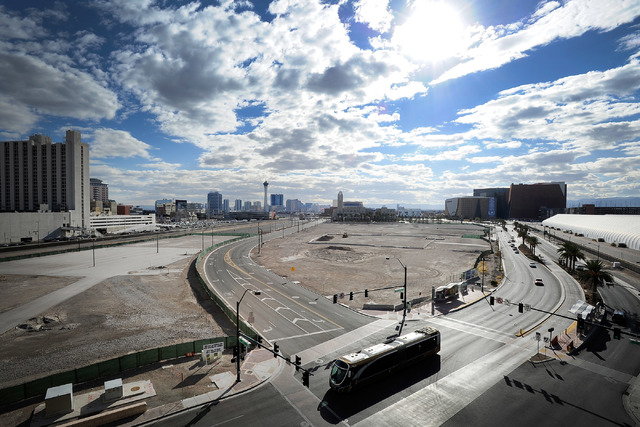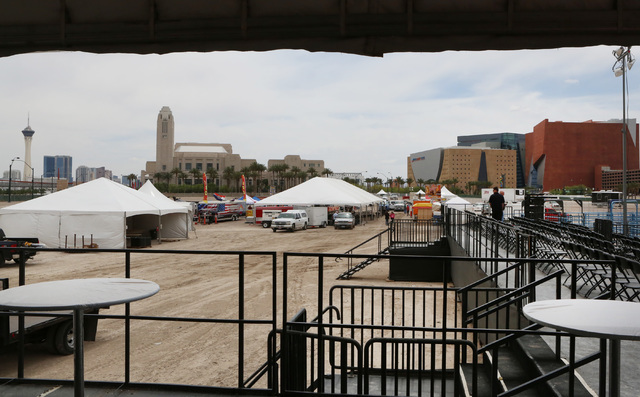City officials upbeat but could settle for less at Symphony Park
City officials are more confident about development at Symphony Park than they have been in years, but the projects that ultimately come in might be substantially less grandiose than what planners were visualizing a decade ago.
The original plans for the 61-acre city-owned downtown space were formulated in the lead-up to the Great Recession when building was booming at what proved an unsustainable rate.
“We believe the time is now. It was pretty tough from 2008 up until a year or so ago,” Deputy Las Vegas City Manager Scott Adams said. “We’re at a point where we believe we can re-engage meaningfully with developers on Symphony Park.”

The city’s website bills Symphony Park as “an exciting project that continues to provide enticing development options.”
City officials have taken a fresh look at the original master plan for Symphony Park. The height and scale of the buildings likely need to be scaled back from what was initially pitched, Adams said.
“You’re probably not going to see 50- and 60-story buildings,” Adams said.
Six- to 10-story offices and five-story residential buildings might ultimately be what pepper the Symphony Park landscape, Adams said.
“It’s going to be a more realistic look at what the development potential is for that tract of property,” Adams said.
Las Vegas Mayor Carolyn Goodman said last week she thinks a smaller scale could work, as long as it’s a “quality project” with interesting and quality architecture.
“The most important thing is times have changed,” Goodman said. “The market’s changed. The people have changed.”
The Symphony Park design standards, finalized in 2006 and updated in 2014, show a variety of possibilities for buildings. Many of the parcels don’t have building height restrictions, and a rendering shows towering buildings.
One perspective depicts a 23-floor tower with basement-level parking, street-level retail and restaurant space, six floors of residential lofts and office space wrapped around parking levels, and 16 floors of “tower-level” residential above that.
Other possibilities show similar mixed-use projects whose designs would have had them stretching even higher into the sky, at 25, 36 or 44 stories.
OPEN FOR BUSINESS
Symphony Park opened in 2005, during then-Mayor Oscar Goodman’s tenure. Later that year, the city signed a project management agreement with California-based Newland Communities, which had been planning to build residential and retail at the site.
Rather than having a private company act as a master developer, the city took on that role, running in utilities and infrastructure and then selling off parcels separately, as a real estate developer would, Adams said.
Some argue that government shouldn’t get itself into the real estate business, but Las Vegas is far from alone.
The city then brought in Newland and gave it rights to do residential development within Symphony Park.
The Cleveland Clinic Lou Ruvo Center for Brain Health opened in 2010, the Smith Center for the Performing Arts opened in 2012 and the Discovery Children’s Museum opened in 2013.
But as the recession ravaged the local real estate market and other deals and plans fell through, prospective taxpaying tenants have come and gone.
If the entities with which the city has agreements on Symphony Park parcels aren’t planning to break ground, the city plans to pursue developers who will follow through on plans.
“If you’re not going to develop your property, we’re going to take it back and find someone who will,” Adams said.
SITE CHALLENGES
The City Council in June authorized the sale of $25 million in sales tax increment revenue bonds to finance a controversial Symphony Park parking garage. The city has spent some $100 million on infrastructure at Symphony Park over the past decade.
A former Union Pacific rail yard, the site is a brownfield and requires environmental cleanup, which adds another obstacle. City officials have been laying out “fairly complex provisions” in agreements with prospective developers on who is responsible for what when it comes to the cleanup, Adams said.
“We will be very careful moving forward with how we engage with developers … so we don’t get ourselves into long-term agreements that don’t yield development results,” Adams said.
City officials hope Newland will come back to the city with proposals for residential development, or that those parcels will be reclaimed by the city which could seek developers who will build residential in Symphony Park.
The escrow closing date for two of the parcels is January 1, while the other three are in early 2019.
City officials are “actively recruiting” developers, specifically those who might tackle non-residential projects — retail or office developments, Adams said.
While the city extended some of its agreements on parcels at Symphony Park as the economy languishes, now that there’s been some recovery, city officials expect developers to begin moving forward with projects there, Adams said.
“Where they haven’t, we’ve been terminating those agreements,” Adams said. “And we’re going to find new partners who are going to move forward with developing those blocks.”
RECENT DEAL FALLS THROUGH
The recession is the most common answer given for why development has been slow to fill in. But deals the city signed with different groups on the parcels have fallen apart for other reasons, too.
The City Council in February approved a land sale to Molasky Group of Cos., which was to be the first private company to develop space in Symphony Park. Molasky planned more than 250,000 square feet of office space across from the Molasky Corporate Center, a project dependent on the company securing the state Department of Business and Industry to move into the new building.
That fell through after the City Council vote when the state opted not to move forward with the project, Molasky Group of Cos. President Rich Worthington said.
Molasky “quickly unwound” its deal with the city after receiving a notification from the state that the project, which had seemed like a done deal, wouldn’t be going forward, Worthington said.
Molasky leaders returned the land to the city so it could potentially find another developer. The office project would have brought 400 employees to Symphony Park, and could have acted as a catalyst for future development, Worthington said.
“We were sorely disappointed when the state decided to pull the plug,” Worthington said.
The Molasky Group of Cos. is still interested in Symphony Park. Worthington mentioned the potential for multifamily residential development or another office building project, but the company has nothing in the pipeline, he said.
“I think it’s a wonderful asset. It’s frustrating they can’t monetize the value of that right now, but I think eventually they will,” Worthington said of the city-owned land. “It’s a prime place for another central business district to emerge.”
Major League Soccer passed in 2015 on the city’s bid for a franchise, killing a controversial proposal for public subsidies to help fund a $200 million, 24,000-seat soccer stadium in Symphony Park.
In 2012, the city signed a deal with Citra Real Estate Capital LLC to build a skilled nursing and assisted living center near the Cleveland Clinic. The city is in litigation over some of the terms of that agreement, and is working toward a settlement, Adams said.
Mayor Carolyn Goodman last week voiced hope that the Cleveland Clinic will expand. She also wants to see the park within Symphony Park expand and mentioned the possibility of a convention space there, she said.
A Cleveland Clinic spokeswoman last week said the medical facility had no news to share about any plans for expansion.
City officials are going to re-evaluate the spaces on a case-by-case basis, but make sure that altogether the projects have the right balance, Goodman said.
“It has to go through the process. It’s really going to have a lot to do with what the council continues to evaluate as proper for the overall site, rather than putting something in that’s poorly thought-through, or putting one thing in there that really doesn’t fit,” Goodman said.
Contact Jamie Munks at jmunks@reviewjournal.com or 702-383-0340. Find @JamieMunksRJ on Twitter.






























